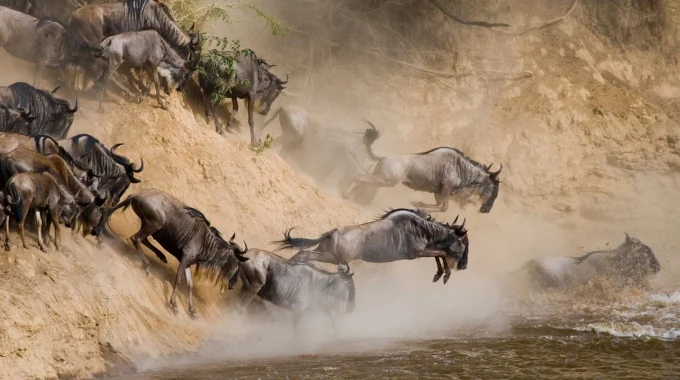A Kenya safari cost can vary significantly based on several factors, such as the season,…
How fast do wildebeest reproduce?
How fast do wildebeest reproduce? –
Wildebeests (Connochaetes spp.) are iconic members of the African savannas and are particularly known for their annual migrations between Kenya and Tanzania. They reproduce annually, with some specific characteristics and patterns tied to the environment and their migratory behavior.

Reproductive Cycle of Wildebeests
-
Mating Season (Rut):
- The mating season for wildebeests generally coincides with the start of the rainy season in East Africa, which is from late November to early December in Kenya and Tanzania.
- Wildebeests tend to calve during a short window of time (around 3–4 weeks) following the mating period, which helps synchronize the births to ensure more calves survive when conditions are most favorable, such as the availability of fresh grasses.
- Male wildebeests will establish territories and defend them during the rut, which includes vocalizations and displays to attract females. Males fight for the right to mate with females within their territory.
-
Gestation Period:
- The gestation period for a wildebeest is approximately 8.5 months (about 250 days), meaning that calves are usually born in the wet season from late May to early June in Kenya and Tanzania.
-
Birth and Calf Development:
- Wildebeests are known for calving synchrony, meaning that large numbers of wildebeests give birth within a relatively short time frame, often over a few weeks in late May and early June.
- A single calf is born per female, and calves can stand and walk within 15–30 minutes after birth. This is essential for their survival because, in the open plains of East Africa, they need to be mobile to avoid predators.
- Calves typically remain with their mothers for protection and suckle until they are old enough to graze on grasses, usually after 2–3 months.
-
Calf Mortality:
- The first few weeks after birth are the most dangerous for calves, as they are vulnerable to predators like lions, hyenas, and crocodiles (during river crossings). Despite this, wildebeests have high reproductive rates to ensure that enough calves survive to reach adulthood.
-
Sexual Maturity:
- Wildebeests reach sexual maturity at around 2.5 years for females and 3–4 years for males, although males often do not successfully mate until they are older and able to compete with dominant males.
Regional Context: Kenya and Tanzania
- Kenya: Wildebeests are found in large numbers in Masai Mara National Reserve and the surrounding areas. The wildebeest population in this region participates in the larger Great Migration that involves millions of wildebeests, as well as zebras and gazelles, moving between Kenya’s Masai Mara and Tanzania’s Serengeti. The timing of the mating and calving is critical for the wildebeests in this area because it synchronizes with the rainy season when food resources are abundant.
- Tanzania: Wildebeests in the Serengeti follow the same general reproductive patterns. However, they experience slightly different environmental conditions, including a more distinct dry and wet season. The Serengeti migration is also a key component of the Great Migration, where the wildebeests move between the Serengeti National Park in Tanzania and the Masai Mara in Kenya.
Factors Influencing Reproduction
- Climate: Rainfall patterns significantly affect reproduction. The abundance of grasses during the rainy season directly impacts the nutritional status of female wildebeests, which in turn affects their reproductive success. Females need to be in good condition to conceive and bear healthy calves.
- Predation: The high predation pressure from carnivores like lions, leopards, and hyenas also influences wildebeest behavior and reproduction. Due to the overwhelming number of newborns, calving synchrony helps reduce the risk of predation for individual calves.
- Migration and Herd Behavior: Wildebeests are gregarious animals, meaning they live in large herds. This social structure provides protection against predators and is important for reproductive success. The Great Migration ensures that new calves are born in areas with plentiful food resources, which boosts their survival rates.
Summary
- Mating Season: November to December.
- Gestation Period: Approximately 8.5 months (250 days).
- Calving Period: Late May to early June, coinciding with the rainy season.
- Reproductive Strategy: Calves are born in synchrony, with most births occurring in a concentrated period to increase survival chances.
- Sexual Maturity: Females mature by 2.5 years, males by 3–4 years.
How fast do wildebeest reproduce? Overall, wildebeests are well-adapted to the environmental and ecological challenges of the East African savanna, with a reproductive strategy that maximizes their chances of survival in one of the most predator-rich ecosystems on Earth.



